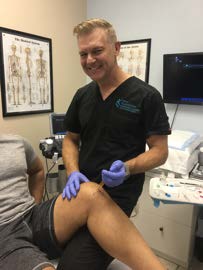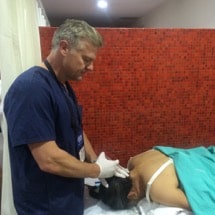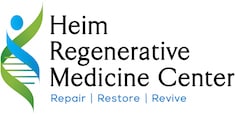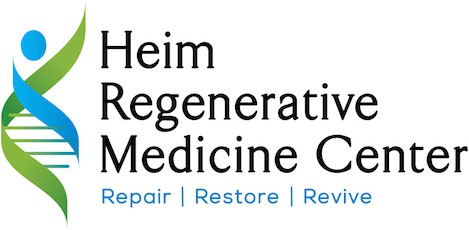The regenerative medicine movement is evolving rapidly. It is also slowly changing medicine.

Although there are still a small percentage of physicians participating in the movement, the ones that are, are pushing back boundaries that are holding us back. The flip side of this movement is that it has become what weight loss clinics were in the 90s and what hormone clinics still are; amphetamine and steroid mills masquerading as medical clinics and driven mostly by money. Now those same clinics are selling PRP (platelet rich plasma) and stem cell treatments like they are magical cure-alls. There are good and bad in all industries, medicine unfortunately is no different. I started down the path of learning the art of regenerative injections in 2012 after having my knee treated before my last Ironman. I had such good results that I bought the equipment so I could perform the procedures on myself. After getting the equipment however, I decided I might as well learn more about the treatments so I could offer them to my patients. That started a continuing education rabbit hole that transformed my practice and introduced me to a handful of special people that changed my life. That rabbit hole has involved dozens of seminars and workshops both in the US and internationally and is still going on today, 7 years later. I’ve spent countless hours in offices of physicians around the country that were good enough to host me and generous enough to share their knowledge with a colleague that was seeking growth as a physician in order to offer the most cutting edge treatments to his patients. Patients who have few options for pain and injury in western medicine save pills and surgery when conservative measures such as rest, ice, massage, and physical therapy don’t work.
My point in describing my journey in this realm of medicine is that you don’t learn the art of prolotherapy, the true injection technique that should be used to treat pain and injury with solutions such as PRP and stem cells, in a weekend seminar. At my first workshop, which included working on cadavers to learn the injection techniques, a physician that has become a mentor to me without even knowing it, gave me two pieces of advice that were invaluable. He told me to learn how to do these injections using palpation to guide you before adding ultrasound guidance to your practice. He also encouraged me to participate in one of the organizations international training sessions. I did exactly what he suggested and now recommend the same to physicians trying to learn these techniques.I did eventually add ultrasound guided injections to my practice which began another long and ongoing educational process that brings another level of precision to the injection process that translates into improved outcomes.

Back to my point about the state of the industry. There are clinics around the country that will promise you the world in exchange for your money and they will perform procedures with little or no training in regenerative injection techniques. I would bet that they have few repeat customers. The reason is that most times they are injecting a joint that has pain without really knowing what the true cause of the pain and so in many cases, not really treating that cause. Knees are a probably the best example to use as I could literally teach a monkey how to inject a knee joint but many, if not most of the time, the joint itself has little or nothing to do with a patient’s pain. Much of chronic pain is caused from laxity in ligaments and tendons that stabilize joints. As joints become unstable, they move too much, causing shearing forces on cartilage, discs, and other structuresthat starts a degeneration process that leads to chronic pain and disability.
To effectively treat a painful knee, before ever picking up a syringe and needle, a good clinician will actually put his hands on you to assess for pain and laxity in a joint. They will then exhaust conservative measures such as rest, physical therapy, and of course time before moving on to more invasive treatments. If regenerative injections are indicated, they will treat the entire joint including all of the stabilizing structures that are involved. Many times when I am treating a patient that has been treated elsewhere without success, I find that they were given a single injection into their knee joint. Although this single injection might do some good, it is a disservice to a patient that really needed a series of injections to address the laxity in the ligaments and tendons that give stability to the joint. This approach will many times non only diminish or resolve the source of a patient’s pain but will also reduce or eliminate a source of ongoing degeneration. Regenerative injections work in multiple ways. First and foremost, the insertion of a needle into an area of injury provides a new injury requiring recruitment of our immune system to turn on our

healing systems.
These healing systems include temporarily increasing inflammation at the site of injury. This process alone, known as dry needling, would help some injuries to improve. The solutions we inject after causing these new micro-injuries, amplify the response in different ways. The original prolotherapy solutions such as dextrose and saline (literally sugar and salt water) amplify the inflammatory process and nourish unhealthy tissue that, due to inflammation and reduced blood flow, have difficulty healing. Other solutions such as platelet rich plasma and stem cells actually participate in the process as we bath the area with the cells that were created to help us heal and by signaling the body to recruit additional resources to accelerate the healing process. This paragraph is regenerative medicine 101 and is at the heart of why I do what I do which is a belief that we have an inherent ability to heal ourselves. This ability is not magic, and it is not absolute. There is a time and a place for medicine, and surgery, and all of the other marvelous advancements medicine has to offer but these are not the only options and in the right scenarios we should allow our bodies to do what they are designed to do. What I am seeing in my practice is most times expected. We treat people appropriately and they usually improve. Like most things however there is a bell curve a percentage of people don’t improve as much as we expect. Then there are the ones that not only exceed my expectations but to put it simply, astound me with their progress. I see this result more with stem cells and believe that trend is going up due to the improvements in how we harvest and store them. We get better every year at how we deliver these treatments and that is how we are pushing the boundaries of medicine in a way that will one day change our approach to many health issues. I am grateful to play a small part in that progress. If you are curious about these treatments and whether or not you are a candidate for them, we offer a free consultation to discuss your options for treatment. Until next time, StayHealthy and Live Well… Dr. Mike


No Comments